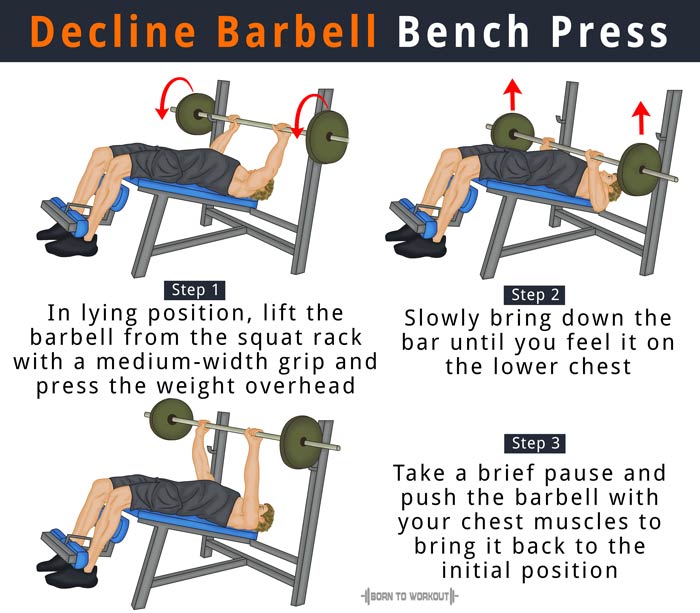🚨 HOW TO BUILD YOUR CHEST
💥 Decline Barbell Bench Press: Forms, Benefits, Muscles Worked
✅ The decline barbell bench press or decline bench press is a strength gaining exercise that trains your upper body by targeting the chest muscles. Many fitness experts and bodybuilding legends like Jay Cutler and Dorian Yates prefer doing this exercise for pectoral development since it works harder on the chest than the flat and incline bench presses. Moreover, the decline bench press puts less stress on your shoulders as compared to its flat counterpart.
[wp_ad_camp_2]

💥 Decline Bench Press Benefits
- Pressing on the decline bench reduces rotation at your shoulders and increases pectoral activation by transmitting stress from the deltoids through the pectoralis major.
- Owing to the decline angle, performing the exercise puts more emphasis on your lower chest than the flat bench press.
[wp_ad_camp_1]
🔥 How to Decline Bench Press
- Lie down so that your back is on the decline bench and your legs are securely locked at the end of the bench.
- Use a medium-width grip (creating a 90-degree angle between your upper arms and forearms) to lift the barbell from the squat rack and press it overhead until your arms are locked. Make sure your arms are perpendicular to the ground. Pause for a second in this starting position.
- Slowly bring down the bar until you feel it on the lower chest.
- Take a brief pause and push the barbell with your chest muscles to bring it back to the initial position. After locking your arms, squeeze your chest to achieve the maximum contracted position. Hold for a few second before coming down with the barbell again.
- Do the recommended number of reps.
[wp_ad_camp_4]
🔥 What is Flat Dumbbell Press (Dumbbell Bench Press)
The dumbbell bench press or flat dumbbell press is arguably one of the most popular gym exercises used for complete chest development. When incorporated into a training regimen, it is usually performed in combination with barbell press since it helps you develop your whole pectoral and shoulder region, giving you a muscular and balanced chest.
[wp_ad_camp_3]

🔥 Flat Dumbbell Press Benefits
- As compared to barbell bench press, the dumbbell flat press is better, safer, and has fewer joint consequences.
- While doing the dumbbell press, there is little or no chance of rebounding or bouncing the dumbbells off the chest like it is when performing the barbell press.
- Using dumbbells for bench pressing improves the range of motion.
[wp_ad_camp_5]
🔥 How to do Flat Dumbbell Press (Dumbbell Bench Press)
- Sit on a flat bench, hold two dumbbells, and keep them in the resting position on top of the thighs so that your palms are facing each other.
- Push your thighs up to assist in raising the weights. Lift the dbs up and hold them at your shoulder
[wp_ad_camp_2]
- Make sure that your palms face away from you by rotating your wrists forward. Keep the dumbbells positioned at the sides of the chest while creating an angle of 90 degrees between your upper arm and forearm. It is the initial position.
- Press the dbs up with the help of your chest to lockout position at the top of the movement. Squeeze your chest and hold the position for a second.
- Slowly lower the weights under control.
- Repeat the steps for the required number of reps of your training regimen.
✅ Caution: Instead of dropping the weights to your side, twist them back to a neutral position so that your palms face each other. Bring the knees up until the dumbbells touch your thighs, and then push your torso up along with performing a kick forward with the legs. The momentum of the movement will help in getting back to the sitting position. Transfer the dumbbells from the top of the thighs to the floor.




















































